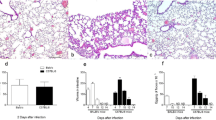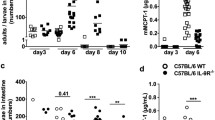Abstract.
To determine the possible role of eosinophils in Angiostrongylus costaricensis infection, both interleukin-5 (IL-5) transgenic (Tg) and non-transgenic (non-Tg) C3H/HeN mice were infected with A. costaricensis third-stage larvae. IL-5 Tg mice demonstrated greater resistance than non-Tg mice to A. costaricensis, as shown by lower adult worm recovery, smaller adults, fewer eggs in the intestinal wall and fewer larvae passed in the feces. Both mice showed similar antigen-specific IgA and IgGl antibody responses, although IgA was more prominent than IgGl. Egg deposition and inflammatory responses in the intestinal walls were milder in IL-5 Tg mice than in non-Tg mice. The eggs with developed larvae, deposited in the intestinal walls of IL-5 Tg mice, were surrounded by numerous degranulating eosinophils and sometimes with Splendore–Hoeppli deposits. The data suggest that eosinophils are involved in the resistance of the mouse during primary infection with A. costaricensis.
Similar content being viewed by others
Author information
Authors and Affiliations
Additional information
Electronic Publication
Rights and permissions
About this article
Cite this article
Sugaya, H., Graeff-Teixeira, C., Ishida, K. et al. Interleukin-5 transgenic mice show augmented resistance to Angiostrongylus costaricensis infection. Parasitol Res 88, 350–355 (2002). https://doi.org/10.1007/s00436-001-0550-y
Received:
Accepted:
Published:
Issue Date:
DOI: https://doi.org/10.1007/s00436-001-0550-y




